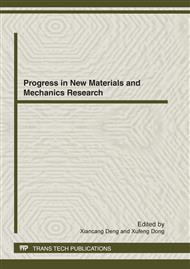[1]
R. Komanduri, Z.B. Hou, Thermal analysis of laser surface transformation hardening—optimization of process parameters, International Journal of Machine Tools and Manufacture. 44 (2004) 991-1008.
DOI: 10.1016/j.ijmachtools.2004.01.011
Google Scholar
[2]
Lin Li, The advances and characteristics of high-power diode laser materials processing, Optics and Lasers in Engineering. 34 (2000) 231-253.
DOI: 10.1016/s0143-8166(00)00066-x
Google Scholar
[3]
Xiu-bo LIU, Gang YU, Jian GUO, et al, Analysis of Laser Surface Hardened Layers of Automobile Engine Cylinder Liner, Journal of Iron and Steel Research, International. 14 (2007) 42-46.
DOI: 10.1016/s1006-706x(07)60010-7
Google Scholar
[4]
Jay C. Rozzi, Frank E. Pfefferkorn, Frank P. Incropera, et al, Transient, three-dimensional heat transfer model for the laser assisted machining of silicon nitride: I. Comparison of predictions with measured surface temperature histories, International Journal of Heat and Mass Transfer. 43 (2000) 1409-1424.
DOI: 10.1016/s0017-9310(99)00217-3
Google Scholar
[5]
Y. Tian, Y.C. Shin, Thermal modeling for laser assisted machining of silicon nitride ceramics with complex features, ASME Journal of Manufacturing Science and Engineering. 128 (2006) 425-434.
DOI: 10.1115/1.2162906
Google Scholar
[6]
Rahul Patwa, Yung C. Shin, Predictive modeling of laser hardening of AISI5150H steels, International Journal of Machine Tools and Manufacture. 47 (2007) 307-320.
DOI: 10.1016/j.ijmachtools.2006.03.016
Google Scholar
[7]
SYSWELD. Engineering guide of training and Toolbox[M]. ESI Group, France, 2004.
Google Scholar
[8]
B. Brickstad, B. L. Josefson, A parametric study of residual stresses in multi-pass butt-welded stainless steel pipes, International Journal Of Pressure Vessels And Piping., 75 (1998) 11-25.
DOI: 10.1016/s0308-0161(97)00117-8
Google Scholar
[9]
M.J. Tobar, C. Álvarez, J.M. Amado, et al, Laser transformation hardening of a tool steel: Simulation-based parameter optimization and experimental results, Surface & Coatings Technology, 200 (2006) 6362-6367.
DOI: 10.1016/j.surfcoat.2005.11.067
Google Scholar
[10]
Chaowen Li, Yong Wang, Bin Han, Microstructure, hardness and stress in melted zone of 42CrMo steel by wide-band laser surface melting, Optics and Lasers in Engineering. 49 (2011) 530-535.
DOI: 10.1016/j.optlaseng.2010.12.008
Google Scholar
[11]
P.J. Cheng, S.C. Lin, An analytical model for the temperature field in the laser forming of sheet metal, Journal of Materials Processing Technology. 101 (2000) 260-267.
DOI: 10.1016/s0924-0136(99)00411-2
Google Scholar


